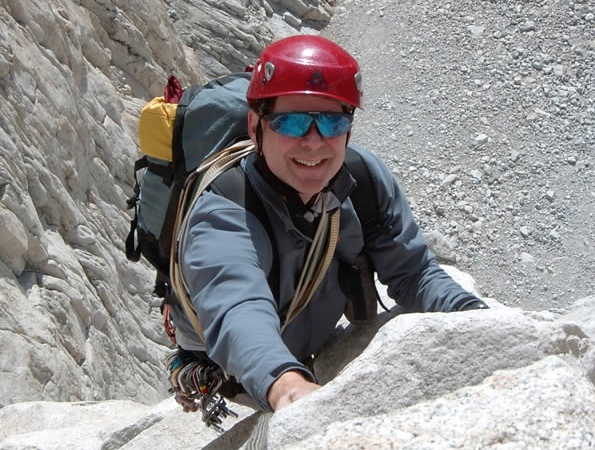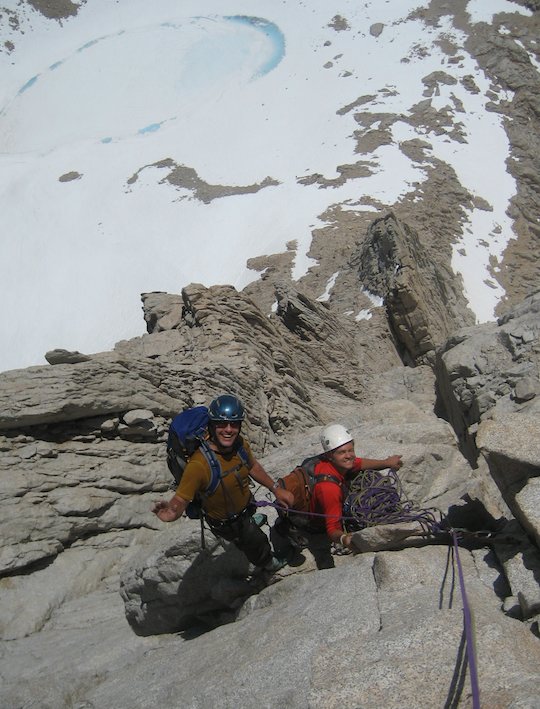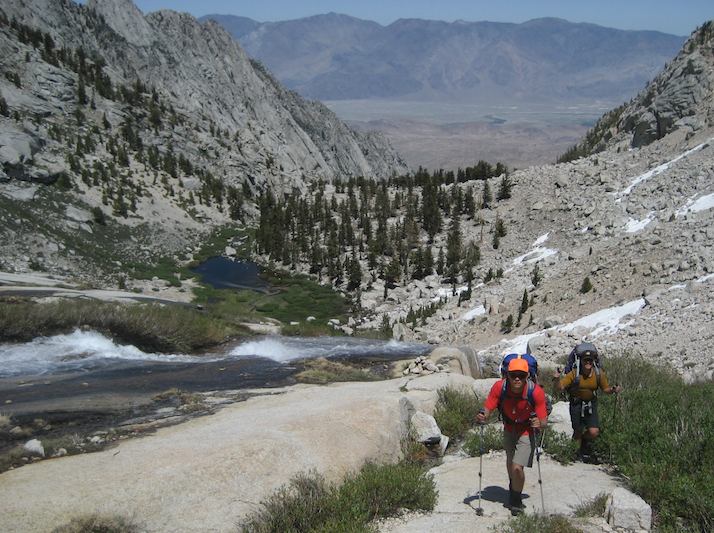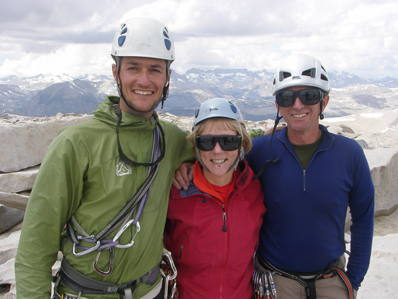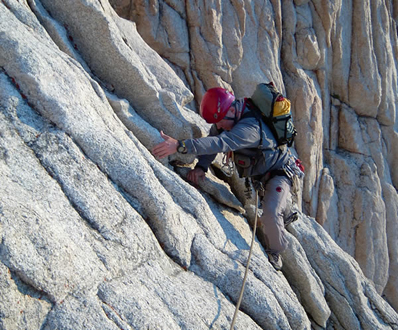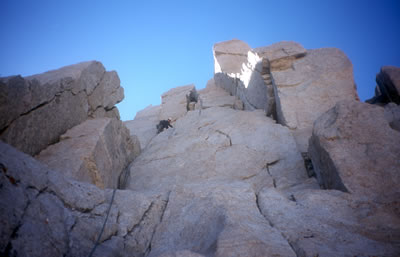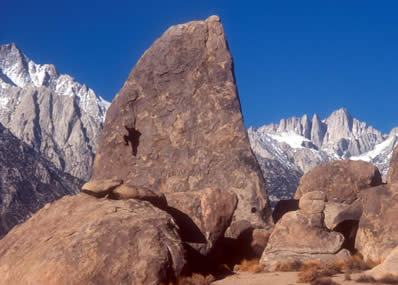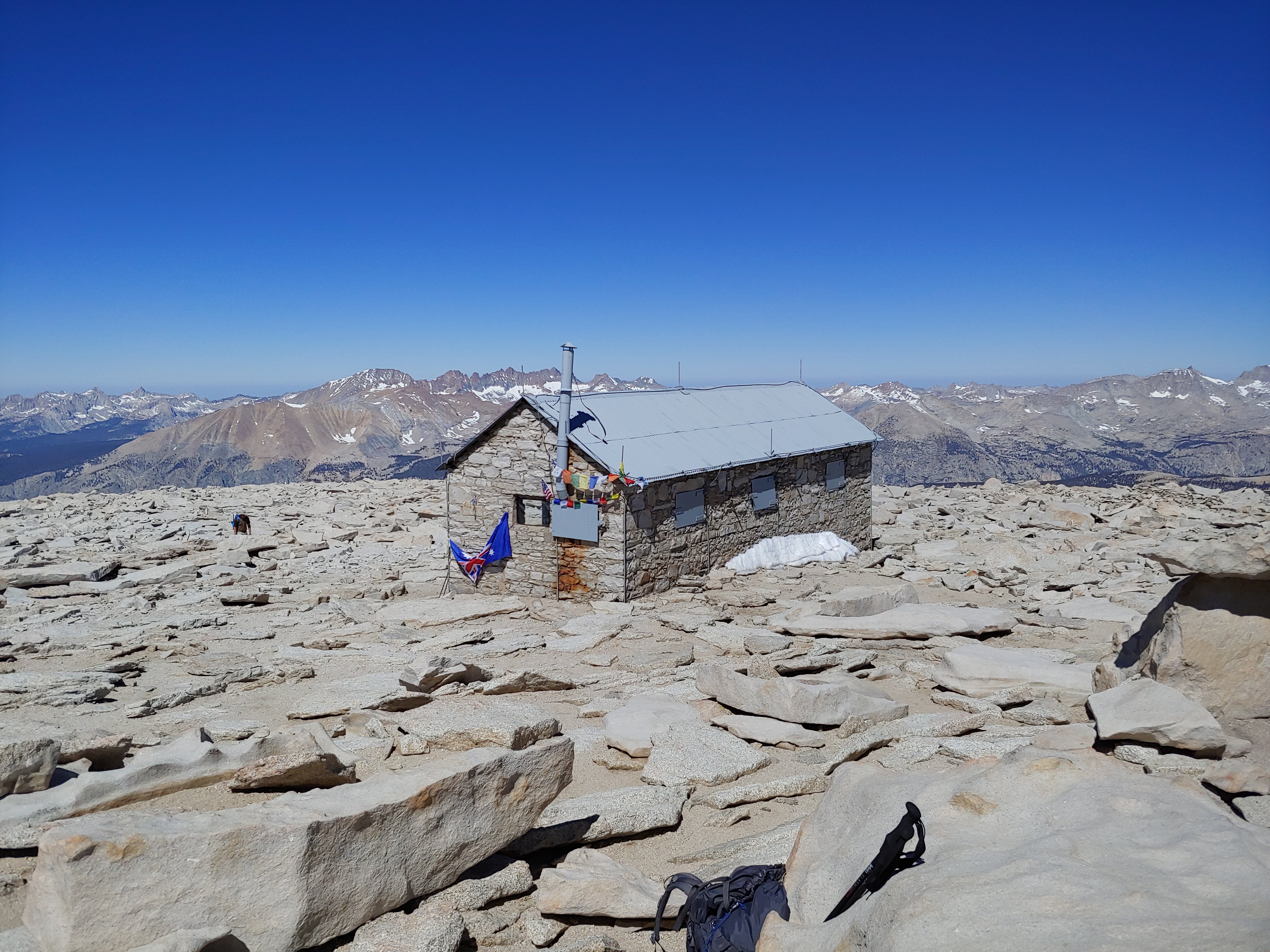Mt. Whitney Climb Overview Rising to 14,505 feet, Mt. Whitney is the highest peak in the lower 48 states and the crown jewel of California's Sierra Nevada. Climbing Mt. Whitney lets you experience one of America's most beautiful alpine settings, with high lakes, meadows, and superb granite.
Most people climb the mountain by way of the Whitney Trail walk-up. However, the mountain has three other alpine climbs on the east side (ranging from moderate to intermediate technical difficulty), and each offers excellent climbing and the opportunity to enjoy a great wilderness experience. The three routes we offer all approach via the North Fork Lone Pine Creek Trail. Though only roughly 5 miles from trailhead to summit, don't under estimate its 6,000 feet of elevation gain; this trail is steep, but the challenge is rewarding.
Mt. Whitney East Buttress - 5.7 from John Grace on Vimeo .
Routes
The Mountaineers Route
Mt. Whitney guide Ian McEleny with climbers on the summit. Mike and Elaine Raymond
For those who enjoy scrambling, the Mountaineers Route is the route of choice. It can be done in a variety of conditions and in all seasons – AAI's Winter Mountaineering course ascends this route in winter.
While it is rated Class 3, which is considered to be non-technical, the climb offers the challenge of both altitude and endurance. We use the same high camp as we do for the East Face and Buttress routes, first backpacking to picturesque Iceberg Lake which is surrounded by peaks over 14,000 feet. Initially our route takes us over moderate snow and ice in the early season and over talus and 3rd class rock in mid and later season. Following a long classic couloir ascent, we make a very photogenic traverse to the north. This upper part of the routes gives moderate exposure and wonderful views especially of the dramatic faces of nearby Mt. Russell. The final climb to the summit is fittingly dramatic for highest peak in the lower 48 states.
Technical Climbs From camp at Iceberg Lake, climbers interested in pursuing more technical ascents on Mt. Whitney have many options. If you do not yet have technical climbing training, you may be interested in our introductory rock and alpine climbing courses in the Sierra Nevada.
The East Face
On the first pitch of the East Face route, Mount Whitney. Justin Wood
This is a moderate climb on a very aesthetic line up Whitney's steep East Face. For those with good basic skills, it is a perfect introduction to technical alpine rock climbing. Our approach to high camp at Iceberg Lake takes us into the beautiful high cirque of the Whitney massif. The route itself features excellent rock on solid moves to 5.6 and significant exposure. We begin with enjoyable and quite varied face and crack climbing on the "Washboard;" higher up we complete the aptly named "Fresh-Air Traverse;" and later end with the 4th and 5th class "Grand Staircase" to the dramatic summit. Although awe inspiring and seemingly forbidding from its base, intermediate rock climbers will find this route to be a suitable challenge and a truly rewarding climb both technically and aesthetically.
The East Buttress
The East Buttress is the classic intermediate route on the east side of Mount Whitney and is a more direct line of ascent compared to the East Face. On this route, climbers will encounter a variety of interesting features including towers, pillars, and gendarmes. Climbing is relatively moderate throughout with the hardest pitches being encountered low on the route including a few short sections of 5.7 and 5.8.
Mt. Whitney Climb Itinerary Climbing in the Alabama Hills with Mount Whitney in the background. Josh Wonner
Day 1: Skills Day - On the first day of your trip, you will meet your Instructor at 8am at a local coffee shop in Mammoth Lakes. After a thorough gear-check, we will make our way to a local rock-climbing crag. Mammoth Lakes is above 8,000’ in elevation, so playing and sleeping here is a great way to help acclimatize.
Sleep: In town, arrange on your own.
Day 2: Approach Day - We will get up very early and drive to Whitney Portal ( 8,360 ’) near Lone Pine. From here we will attempt to hike to Iceberg Lake (12,650’). The trail is a steep four-mile climb with a variety of terrain at every bend. Depending on the objective and how people are adapting to altitude, some parties may prefer to camp slightly lower at Upper Boy Scout Lake (11,350’).
Elevation Gain: abt. 3,100 to Upper Boy Scout Lake or 4,300 to Iceberg Lake
Distance: about 3.4 - 4 miles on trail with a few exposed 3rd class sections and through a variety of terrain; expect rock, brush, dirt, seasonal stream crossings.
Sleep: At Camp
Day 3: Summit Day - We typically leave our camp around 5 or 6 am and summit 4 - 6 hours later. (This is also a contingency day if another day acclimatizing is needed. Summit day will be moved to day 4 and you will hike out same day.)
Elevation Gain 2,000'. Estimated Time 6 - 12 hours roundtrip from Iceberg Lake.
Sleep: At Camp
Day 4: Descent Day - From camp take the trail back to the trailhead. Stop at Whitney Portal Store for a well deserved snack, split a gigantic pancake, or head back to Mammoth Lakes. You should plan to depart the following day.
Sleep: In town, arrange on your own.
Mt. Whitney Climb Cost and Details The following per person prices are based on final climber to guide ratios for 4 day public climbs. For private trips, adjusted itineraries, or shorter or longer lengths, please click HERE for our Private Sierra Programming rates.
Mountaineer's Route – Max Ratio 3:1
4 Days (prices are per person, per day):
3:1 = $360
2:1 = $485
1:1 = $675
East Face or East Buttress – Max Ratio 2:1
4 Days:
Prerequisites
Mountaineer's Route:
Excellent physical condition
Multi-day/overnight self supported backpacking experience
Ability to cook for yourself on a back-country stove
Ability to move through rough talus-like terrain
Expect to gain 6,000 feet over 5 miles in distance
East Face or East Buttress: All of the above, plus the ability to follow 5.6 (East Face) or 5.8 (East Buttress) multi-pitch rock climbs.
Cost Inclusions and Exclusions Inclusions: Included in the course cost is group technical climbing equipment, permits and backcountry camping fees, and the guide fee.
Exclusions: Not included in the course cost is all personal clothing and climbing gear (including crampons, ice axe, harness, helmet, tent, etc), gratuities to guide, meals while on the course, transportation, or travel insurance. You will also be responsible for your own lodging/camping the first night if enrolled in the four day course option.
Getting There The meeting location is Mammoth Lakes, CA.
Most climbers will fly into Reno, NV where there are numerous flights from all over the U.S. The drive from Reno to Mammoth Lakes is about 3 hours in the summer. Other common options are flying into Los Angeles, CA or Las Vegas, NV.
If arriving in the summer months mid May through mid October, a 2-wheel drive vehicle is fine. If coming in early or late season, it's better to have 4-wheel drive, or at least front wheel drive with chains and good clearance.
Distance from Mammoth Lakes to Mt. Whitney Trailhead is approximately 2 hours.
Lodging and Transportation Mammoth Lakes, CA which is a small resort town with a variety of accommodations and camping locations you can take advantage of before or after your course.
You should come prepared to drive yourself and your instructor from the meeting location to the climbing areas and trailhead and return. If you would like assistance arranging a rental vehicle please feel free to contact our Travel Coordinator, Lisa Greif, at 509-972-4028.
Your travel dates should allow for an arrival in town the day before your program begins and for departure the day after your trip ends. We do not recommend that you fly out any earlier than the day after your course.
Travel Insurance
We strongly recommend that you purchase comprehensive travel insurance that includes trip cancellation coverage. Ripcord is our primary travel insurance provider, offering coverage for trip cancellation, trip delay, baggage, medical evacuation and other eventualities.
Unlike many vacations that are less physically demanding, a climbing and trekking vacation can be ruined by an illness or relatively minor injury that occurs before departure. While you can still tour a city or head to the beach with a sprained ankle or a very bad cold (albeit, less conveniently), such an injury or common illness can stop you in your tracks short of your climbing or trekking destination.
AAI Rental Equipment
The following items are available to rent through us in the Sierra and your guide will bring these to your rendezvous on Day 1. A rental request form will be included in your Program Confirmation email.
helmets
harnesses
backpacks
tents
cooking gear (stove/pot/fuel)
ice axes
crampons
ice tools
avalanche gear (beacon/probe/shovel)
snowshoes
Please note that we do not rent boots, sleeping bags, or sleeping pads in the Sierra; your best option for these items is to contact Eastside Sports in Bishop, CA, or Mammoth Mountaineering in Mammoth Lakes, CA.
If you are renting through local gear shops, factor in time to pick-up/return rental items before and after your course.
Mt. Whitney Climb Dates Mt. Whitney Skills and Climb Course
2024 Dates:
July 11 - 14, 2024
August 15 - 18,2024
Mt Whitney is a very popular climb plan early to secure your dates.
Alternate private/custom dates (3 day minimum) may be available pending permit approval and guide availability. Please call our office for custom trip options or please click HERE for our Private Sierra Programming rates.
For winter climbing in the Sierra/Mt. Whitney (December - April), please refer to our Winter Mountaineering in the Sierra page.
Mt. Whitney Climb Testimonials "What a trip! Thanks to my guide and all the work he did to make this climb come together. He was very sensitive to any short comings his clients may have had, we had a ball."Bruce Worley, New Orleans, LA
"I just returned from a successful climb last Saturday of the East Face of Mt. Whitney, and my guide was outstanding in all respects. I have used guides from all of the well-known Northwest guide services at one time or another in the last six or seven years, and found my AAI guide to be knowledgeable, industrious, safe, and an excellent climbing guide. I wholeheartedly will recommend him to others, and would look forward to climbing with him in the future, should the opportunity arise. Thanks, AAI, for setting up a most enjoyable climb. "Lew Miller, Richland, WA
"Our guide was professional, informative, and patient. He knew exactly when to push, pull, and push again. He was keenly aware of our safety, and his combined guidance and knowledge made him an excellent teacher/companion." James Reggio, Plainview, NY
"My guide was very professional in his approach for our climb. We weren't sure about spending 3 nights on the mountain but he convinced us that it would help us in the long run. He was so right. He was very patient and helpful with our climbing skills. I think he was a big reason we were successful in our endeavor. As he put it at the top, "I have two 53 year old moms who just climbed the East Buttress of Mt. Whitney." We received a standing ovation from the people up there. It was a great trip that I am sure Anne and I will never forget. I would climb with him any day . He challenged us but kept us safe as well. Overall an unforgettable experience. We are hoping to climb with AAI again whenever we get the chance and hopefully with the same guide. Thanks for an incredible life experience!"Mary Clare Johnson, Riverwooods, IL
Mt. Whitney Climb Related Courses
Program Finder
By Location
United States - Alaska
United States - Washington
United States - California
United States - Nevada
United States - Colorado
United States - Utah
Canada - British Columbia
South America - Argentina
South America - Bolivia
South America - Ecuador
South America - Patagonia
South America - Peru
Europe - Alps and Caucasus
Asia - Nepal and Tibet
Asia - Laos, Thailand, & Vietnam
Asia - China
Asia - Japan
Africa - Tanzania
Pacific and Antarctica
By Program Type
Instructional Courses
Group Summit Climbs
Expeditions
Skills Expeditions
Private Guided Programs
Treks, Tours, & Backpacking
Corporate Outings & Services
Government & Military
By Activity
Rock Climbing
Ice Climbing
Alpine Climbing
High-Altitude Climbing
Trekking and Backpacking
Skiing & Snowboarding
Guide Training & Rescue
Avalanche Training
Departure Month
Difficulty Level
Beginner
Moderate
Intermediate
Advanced
Very Advanced
x
